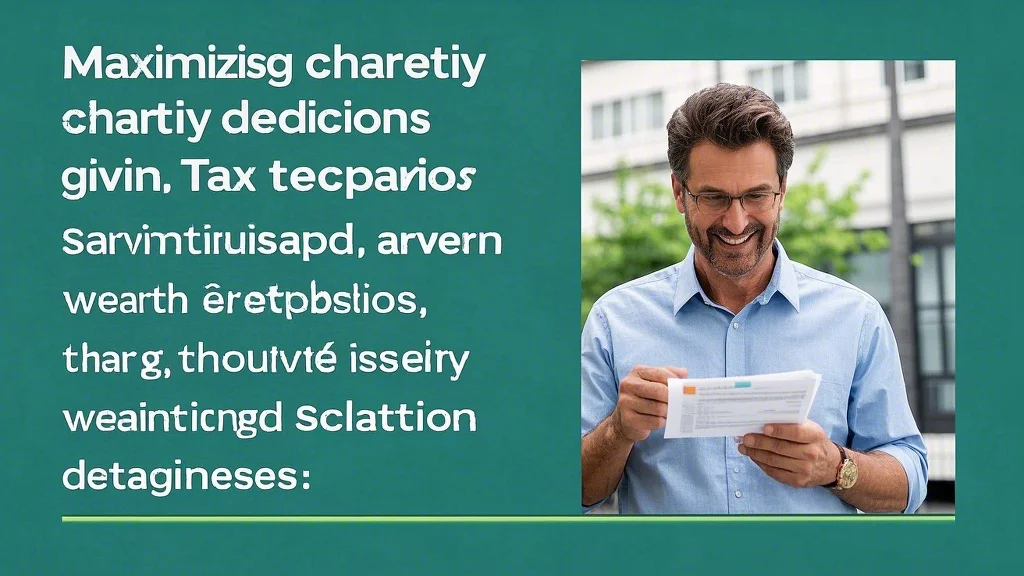Understanding Charitable Deduction Limits
Navigating the complex rules surrounding charitable tax deductions begins with understanding the various IRS limits that apply to different types of donations. Cash contributions to public charities are generally deductible up to 60% of your adjusted gross income (AGI), while donations of appreciated assets like stocks or real estate are typically limited to 30% of AGI. These thresholds form the foundation of effective tax-saving strategies for philanthropically-minded individuals. What many donors fail to realize is that excess contributions can be carried forward for up to five years, allowing you to maximize deductions over time rather than losing them entirely.
High-net-worth individuals should pay particular attention to the Pease limitation, which reduces itemized deductions by 3% of AGI above certain thresholds. This makes tax-efficient donations even more critical for those in higher tax brackets. The qualified charitable distribution (QCD) rule offers a valuable exception – those over 70½ can donate up to $105,000 directly from their IRA to charity in 2024, which counts toward required minimum distributions but isn’t included in AGI at all. These nuanced rules demonstrate why comprehensive wealth management and charity planning requires specialized knowledge to navigate properly.
Donating Appreciated Assets for Maximum Benefit
One of the most powerful tax-saving strategies available to investors involves donating appreciated securities rather than cash. When you give stocks, mutual funds, or other investments held more than one year, you avoid paying capital gains taxes while still claiming the full fair market value as a charitable deduction. This double benefit makes appreciated securities among the most tax-efficient donations possible. For example, donating $10,000 worth of stock that originally cost $2,000 saves you from paying $1,200 in capital gains tax (assuming a 15% rate) while still providing the full $10,000 deduction against your income.
Implementing this strategy effectively requires coordination with your wealth management and charity professionals. The process involves transferring securities directly to the charity or donor-advised fund rather than selling them first. Timing matters too – donating during years when you have other capital gains to offset can amplify the benefits. As part of comprehensive tax strategies for philanthropists, consider establishing a giving plan that identifies which assets to donate and when, based on their cost basis, current value, and your overall tax situation.

Leveraging Donor-Advised Funds for Flexibility
Donor-advised funds (DAFs) have become essential tools in modern charitable tax deductions strategies. These philanthropic vehicles allow you to make a charitable contribution and claim the tax deduction in the current year, while distributing grants to charities over time. This “bunching” strategy is particularly valuable for those who alternate between itemizing and taking the standard deduction. By making several years’ worth of donations into a DAF in a single year, you can surpass the standard deduction threshold and maximize your tax-saving strategies in that year.
DAFs also excel at facilitating tax-efficient donations of complex assets like private company stock, real estate, or cryptocurrency that many charities aren’t equipped to handle directly. The funds provide anonymity if desired and simplify record-keeping with a single receipt for tax purposes. For those implementing sophisticated wealth management and charity plans, DAFs can serve as the central hub for all charitable giving, allowing for strategic grant timing and family involvement in philanthropic decisions. When combined with other tax strategies for philanthropists, they create a powerful system for managing charitable impact and tax benefits simultaneously.
Private Foundations vs. Public Charities
High-net-worth philanthropists often face the choice between donating to public charities or establishing private foundations as part of their charitable tax deductions strategy. Private foundations offer more control over charitable activities but come with stricter rules and lower deduction limits – typically 30% of AGI for cash and 20% for appreciated assets compared to public charities’ 60% and 30% limits. This distinction makes them less tax-efficient donations vehicles from a pure tax perspective, though they may better serve specific philanthropic goals.
For those committed to wealth management and charity at scale, a hybrid approach often works best. You might establish a private foundation for long-term family philanthropy while using donor-advised funds at public charities for more tax-saving strategies. Some families create supporting organizations that operate like private foundations but qualify for the higher public charity deduction limits. These decisions require careful analysis of your charitable objectives, expected annual giving amounts, and desire for family involvement – all key considerations in comprehensive tax strategies for philanthropists.
Timing Your Charitable Contributions Strategically
Proper timing represents one of the most overlooked aspects of effective charitable tax deductions. Accelerating donations into high-income years can provide outsized tax benefits, especially if you expect lower income in future years. This approach forms a critical component of holistic tax-saving strategies that coordinate charitable giving with other financial events like business sales, stock option exercises, or large capital gains. The difference between donating in a 37% tax bracket year versus a 24% year could mean thousands in additional tax savings for the same gift amount.
Retirees should pay particular attention to how tax-efficient donations interact with required minimum distributions (RMDs) and Social Security taxation. Qualified charitable distributions (QCDs) from IRAs become available at age 70½ and can satisfy RMDs without increasing your adjusted gross income – particularly valuable for those concerned about Medicare premium surcharges or taxation of Social Security benefits. These techniques demonstrate how wealth management and charity must evolve as you transition from accumulation to distribution phases of your financial life. Incorporating charitable timing into your overall tax strategies for philanthropists can significantly enhance both your philanthropic impact and tax efficiency.
Documentation and Compliance for Charitable Deductions
Proper documentation is the linchpin of successful charitable tax deductions. The IRS requires written acknowledgment from the charity for any donation of $250 or more, and specific rules apply to different types of gifts. Non-cash donations over $5,000 generally require a qualified appraisal, while vehicles, artwork, and other complex gifts have their own reporting requirements. These rules make meticulous record-keeping an essential part of any tax-saving strategies involving charitable giving.
Working with experienced professionals ensures your tax-efficient donations withstand IRS scrutiny while maximizing their benefit. Your wealth management and charity team should include a tax advisor familiar with charitable giving rules and potentially a specialized appraiser for non-cash gifts. Many high-net-worth philanthropists maintain a “charitable giving file” that tracks donations, acknowledgments, and supporting documentation throughout the year. This proactive approach to implementing tax strategies for philanthropists prevents last-minute scrambling at tax time and ensures you’re prepared if the IRS questions your deductions.
